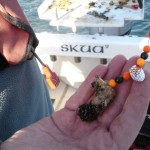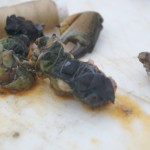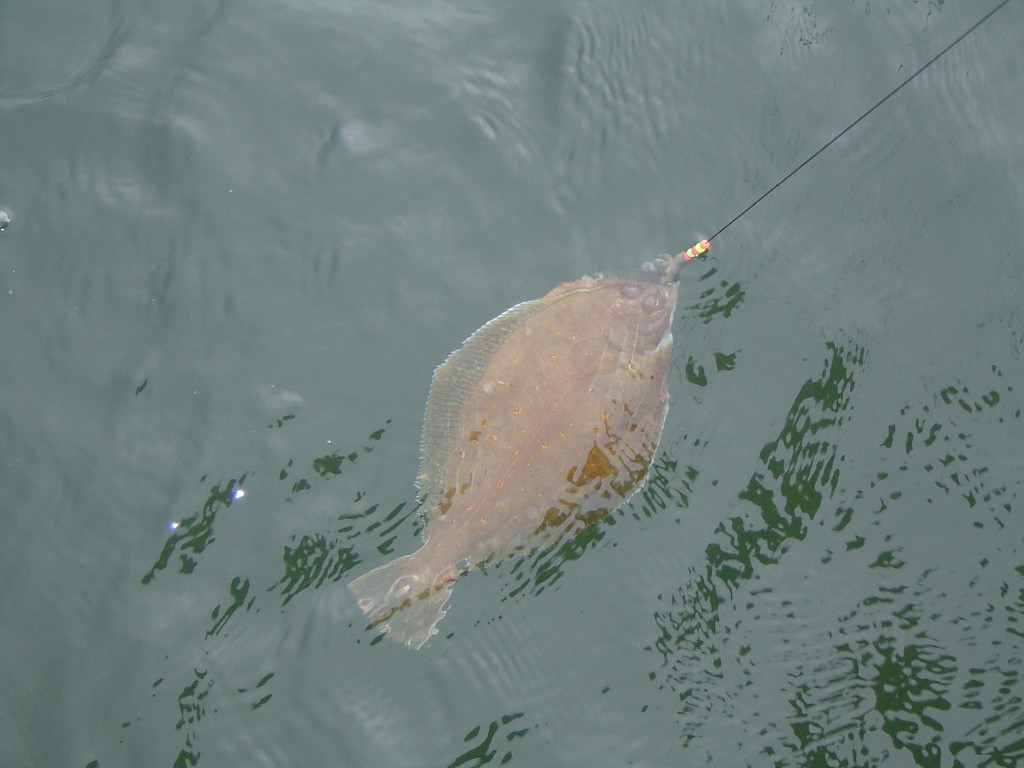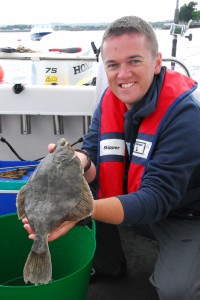A specimen flounder from your boat? You might just have to take to the shore! This is a great species to target and more fun than you would think when the tackle is light and the tactics varied. Jim Clohessy is searching for a fat flattie…
As winter bites and dinghy anglers get tired of waiting for weather or indeed are hankering for some variety in species there are more and more trying their hand on a fish that does not get enough praise for its abilities. Flounder are not a fish known for their fighting abilities nor as a fish that lends itself to frenetic fishing and active fishing tactics. Maybe we have got it wrong. I learned my flounder fishing during trips shore fishing around the country. I would have always considered them as being a bycatch that would be caught while fishing for bass or rays. I would rarely if ever head fishing specifically for flounder. Even when you were fishing you would watch the your rod tip and when you spotted the knock rather than holding the rod you would be encouraged to take “the flounder walk”, giving the fish time to engulf the bait and basically to hook itself before reeling the fish in. Not exactly challenging! As time has gone on anglers are getting better at suiting the tackle to the target species, basically using the lightest gear possible to get a bait to the area in the vicinity of the fish. I was guilty of out gunning the target fish for years, not any more though. Many of us underestimated the flounder and ended up fishing with large beach casting rods when we fished from the shore and using general boat roads when fishing from the dinghy. Based on old misconceptions you could imaging the flounder lounging around on the bottom waiting for a tasty morsel of crab to pass by or happened to be cast near enough to eaten. I have watched flounders when snorkelling and nothing could be further than the truth. Flounders are active predators that move around their area and actively seek out prey. Once they see their prey they attack aggressively. The lazy reputation is undeserved and not correct.
I am no marine biologist. I do not claim to have any great insight into the life cycle of the flounder. Like others I do recognise patterns in my angling. I catch greater numbers of plump flounder in the late autumn and winter than any other time of the year. I speak with other anglers who have more experience than me and they concur – plump, well fed flounder arrive into the estuaries late in the year, your chances of catching a better fish increase in winter time. Why are the fish arriving in the estuaries? Why are they in such good condition? Your guess is as good as mine. They could be getting ready for some spawning activity. I do not keep flounders for the table so I have never carried out a post mortem. Maybe they are fattening themselves up for breeding activity later in the spring and estuaries provide the crab, worms and fish in abundance. One thing is for sure: other than periods of rest around slack water, on both the incoming and outgoing tide flounders will be on the move and actively hunting down food.
I love a few sessions of flounder fishing from the boat. Once it was a recipe for a relaxing no-pressure trip. A bucket of crab, a few worms for variety, a couple of light rods and you were sorted. Times have moved on and now flounder fishing has become as frenetic a trip as bass fishing or a good pollacking session. The reason is simple – there are more ways than one to skin a cat. There are also more ways than one to catch flounder. Rather than the usual chuck it and wait tactics there are many methods you can experiment with. Even the chuck it and wait mentality must go out the window if you want to catch consistently. Throw a float into the mix and you are starting to get busy, rig up some soft plastics and now you will not have a moment to spare. Cups of tea how are ya!
Gearing up for flounders is not a major issue. They are not the fussiest of fish and therefore can be caught on various style traces. Anything you use from the strand will work from the boat. It may be advantageous to make you traces shorter for boat fishing than you would from the shore. This is more to allow you to cast and flick from the boat somewhat easier especially if you are using a shorter rod than you would use from the shore. Over time I have experimented with legers and paternosters, with spoons, beads and blades and I have settled on a few traces that do the business for me time after time. My favourite is probably the most simple and effective trace. I tie up a simple one up one down trace from 20lb fluorocarbon. No beads, no bangles, nothing other than a pair of size one hooks. I do not even use swivels. The upper snood is tied with a dropper loop and the weight is fixed to another dropper loop and a link clip. All told this trace is about three feet long, an ideal length to be handled with a light multi-tip boat rod or a spinning rod of up to eight feet long. I will also use a two hook leger with a few luminous beads and spinner blades. Again I will tie this up at around three feet long to allow the trace to be easily flicked from the boat. Two rods and all the bases are covered, leger and paternoster, bling and no bling. If pressed and was asked to choose only one trace I would take the plain one up /one down as it catches consistently and it will also attract bass, other flatties and even eels. The reason I use a link clip for my lead is that I will change the lead regularly in order to have “just enough” lead to hold bottom. Once I bait up I will generally send one trace far downtide and the other I will flick a few feet away from the noise of the boat. From there it is a steady work rate as I keep the baits moving through the water every few minutes. You have a choice here – lift and draw the bait back towards the boat a couple of feet at a time or lift the light lead and let the bait travel down tide a couple of feet before dropping the bait back on the bottom. It is great fishing because you cannot stop looking at the rod tips. A flounder may give a bite akin to a big bass of it may just snuggle up to the bait and give the faintest of indications. After seeing the bite I normally give the fish a little time, old habits die hard, before lifting into the fish. A flounder hooked on a light spinning rod in a flowing tide can give a fabulous fight. Like plaice or any flattie they use their flat bodies to kite in the tide and they are capable of mad bursts of speed than will pull out a light hook if your drag is not set correctly. The sight of a flatfish coming to the net always sets my pulse racing.
As an alternative to the standard bait fishing techniques it is worth trying some experimentation. Flounders will chase a bait so float techniques are well worth a go. If you can get the right area to try in your locality you may find you will get hooked on this technique as it is very intensive and keeps you busy all through your session. Estuaries make great areas for float fishing. If you can find an area of mud where the depth is consistent you can easily float fish. Simply use a cigar float with a sliding stop knot and a single baited hook length. As well as the weight to cock the float use some split shot close to the hook to keep the bait close to the bottom. Set your depth at the side of the boat and flick the trace into the tide. If the trace gets snagged or picked up by crabs adjust your float by a few inches and try again. The float should work its way down tide at a steady pace. Once you are struggling to see your float it is time to retrieve and cast again. Bites will be brisk and the chances are your fish will be hooked in the lip – unusual for flounder fishing old-style. This technique may just throw up some surprises expect to pick the odd bass this way too! The second alternative to standard bait fishing is to go the soft plastic route. This is a method I am just getting into and it is an active method and is great for cold winter conditions. I have had some success using seven gram leadheads and small plastics around two inches in length. I have had success with the megabass hazeldong and even the tail pulled from a standard jelly worm and hooked on a small leadhead. I am looking forward to trying some shrimp-style plastics this year. The difficulties I have encountered are firstly getting the little leadhead out and away from the boat. You may find you will have to go very light with your mainline. Last year I started to use StrikePro’s excellent Strike Wire braid and it has changed the way I fish soft plastics. This braid is nearly half as thin as you usual braid. As a result you will get distances you only dreamed of from lighter leads. The effect really has to be seen to be believed and not just for flounder super braids combined with the right rod will give you a new level of success when bass fishing as well – guaranteed. Water clarity is always an issue when using soft plastics and therefore do your experimenting only during a settled spell of weather when the water clarity is best. Avoid times when there is lots of muddy water in the system. Flick from the boat, leave the leadhead sink to the bottom, it takes practice to know when a light weight had touched down, and deftly flick the rod tip and impart some action to the lure. Let the lure sink to the bottom again while retrieving maybe a foot or two of line. Take your time this is not spinning as we know it. The take will be quick and like no flounder you have ever caught before!
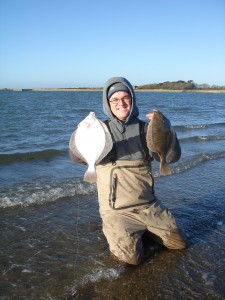
A brace of decent shore caught flatties – Shore fishing may be the best alternative during the winter
It is not practical to have a multitude of rods on board for every species and technique. Your bank balance would not handle it is any case so it is a matter of selecting rods that will allow you get the best out of a range of tactics. Everyone should have a light rod on board for some experimenting and there are many new-style spinning rods specifically designed for the boat angler who wants to experiment with the softies as well as being able to chuck a plug or jig the required distance. Every manufacturer has a range of light but strong rods to be used from both boat and shore. Think of the Surecatch Salty Spin. Think of the Abu Garcia RockSweeper Nano. Ask your dealer to get a few of these rods for you to look at. The range goes from 7-30 gram soft plastic rods that are expensive to similar style rods that are designed for the thrifty angler or the angler that wants to dip their toe in the minefield that is soft plastic fishing without having to get a mortgage. These rods will all chuck a plug and they will also double up as rods that will allow you get the most from your fishing for smaller species. Just when I was singing the praises of the Surecatch Vicuna range of spinning rods they have gone and replaced them! Watch out for the Surecatch Power Braid Salty Spin. I only got a feel of them on dry land but they look like being the perfect entry level light rod for getting the most out of the light stuff this year. Of course you can also prepare for an onslaught from Hart tackle, look out for the mid-range Epitaph and Finneza Hedge as being great short all-round spinning rods. All these rods are anywhere from 1.8 to 2.2 metres and as such are perfect for the boat. They will store on-board ever ready for when the opportunity arises. Mate one of these rods with a 2500 to a 4000 size reel loaded with Strikewire and let the fun begin whether it will be bass, pollack or flounders that will float you boat this year.
Once you are equipped to suit the species you will enjoy the fishing even more. Suddenly smaller species take on new levels of satisfaction and fun. You will find you will fish more often as you will get more from fishing within sheltered waters. A specimen flounder is a realistic target in most areas around the country. A specimen of 1.1 kg will be a well deserved capture though it may take some time to work out the better areas to fish and the best times to fish there. I have not managed to capture the elusive big one yet. I could not have realistically hoped to get the “big one” before as I never did enough flounder fishing. Using the right gear and experimenting with new techniques has led to the species taking on new meaning for me. Flounders are worth fishing for. I know I will be doing more flounder fishing this year than ever before – watch out fatties!


